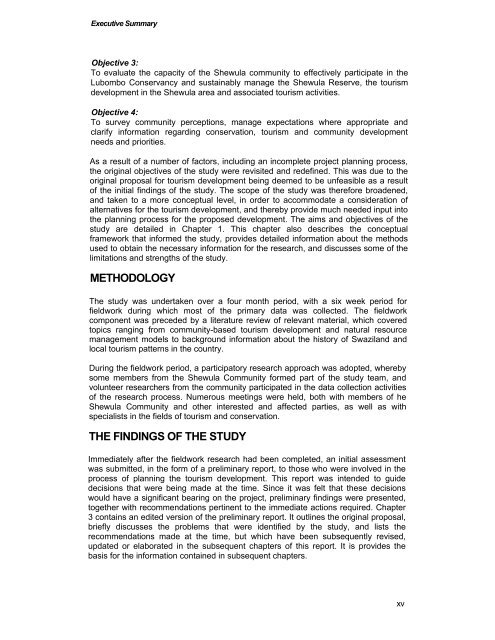Feasibility Study of Proposed Tourism Dev in Shewula, NE ...
Feasibility Study of Proposed Tourism Dev in Shewula, NE ...
Feasibility Study of Proposed Tourism Dev in Shewula, NE ...
Create successful ePaper yourself
Turn your PDF publications into a flip-book with our unique Google optimized e-Paper software.
Executive Summary<br />
Objective 3:<br />
To evaluate the capacity <strong>of</strong> the <strong>Shewula</strong> community to effectively participate <strong>in</strong> the<br />
Lubombo Conservancy and susta<strong>in</strong>ably manage the <strong>Shewula</strong> Reserve, the tourism<br />
development <strong>in</strong> the <strong>Shewula</strong> area and associated tourism activities.<br />
Objective 4:<br />
To survey community perceptions, manage expectations where appropriate and<br />
clarify <strong>in</strong>formation regard<strong>in</strong>g conservation, tourism and community development<br />
needs and priorities.<br />
As a result <strong>of</strong> a number <strong>of</strong> factors, <strong>in</strong>clud<strong>in</strong>g an <strong>in</strong>complete project plann<strong>in</strong>g process,<br />
the orig<strong>in</strong>al objectives <strong>of</strong> the study were revisited and redef<strong>in</strong>ed. This was due to the<br />
orig<strong>in</strong>al proposal for tourism development be<strong>in</strong>g deemed to be unfeasible as a result<br />
<strong>of</strong> the <strong>in</strong>itial f<strong>in</strong>d<strong>in</strong>gs <strong>of</strong> the study. The scope <strong>of</strong> the study was therefore broadened,<br />
and taken to a more conceptual level, <strong>in</strong> order to accommodate a consideration <strong>of</strong><br />
alternatives for the tourism development, and thereby provide much needed <strong>in</strong>put <strong>in</strong>to<br />
the plann<strong>in</strong>g process for the proposed development. The aims and objectives <strong>of</strong> the<br />
study are detailed <strong>in</strong> Chapter 1. This chapter also describes the conceptual<br />
framework that <strong>in</strong>formed the study, provides detailed <strong>in</strong>formation about the methods<br />
used to obta<strong>in</strong> the necessary <strong>in</strong>formation for the research, and discusses some <strong>of</strong> the<br />
limitations and strengths <strong>of</strong> the study.<br />
METHODOLOGY<br />
The study was undertaken over a four month period, with a six week period for<br />
fieldwork dur<strong>in</strong>g which most <strong>of</strong> the primary data was collected. The fieldwork<br />
component was preceded by a literature review <strong>of</strong> relevant material, which covered<br />
topics rang<strong>in</strong>g from community-based tourism development and natural resource<br />
management models to background <strong>in</strong>formation about the history <strong>of</strong> Swaziland and<br />
local tourism patterns <strong>in</strong> the country.<br />
Dur<strong>in</strong>g the fieldwork period, a participatory research approach was adopted, whereby<br />
some members from the <strong>Shewula</strong> Community formed part <strong>of</strong> the study team, and<br />
volunteer researchers from the community participated <strong>in</strong> the data collection activities<br />
<strong>of</strong> the research process. Numerous meet<strong>in</strong>gs were held, both with members <strong>of</strong> he<br />
<strong>Shewula</strong> Community and other <strong>in</strong>terested and affected parties, as well as with<br />
specialists <strong>in</strong> the fields <strong>of</strong> tourism and conservation.<br />
THE FINDINGS OF THE STUDY<br />
Immediately after the fieldwork research had been completed, an <strong>in</strong>itial assessment<br />
was submitted, <strong>in</strong> the form <strong>of</strong> a prelim<strong>in</strong>ary report, to those who were <strong>in</strong>volved <strong>in</strong> the<br />
process <strong>of</strong> plann<strong>in</strong>g the tourism development. This report was <strong>in</strong>tended to guide<br />
decisions that were be<strong>in</strong>g made at the time. S<strong>in</strong>ce it was felt that these decisions<br />
would have a significant bear<strong>in</strong>g on the project, prelim<strong>in</strong>ary f<strong>in</strong>d<strong>in</strong>gs were presented,<br />
together with recommendations pert<strong>in</strong>ent to the immediate actions required. Chapter<br />
3 conta<strong>in</strong>s an edited version <strong>of</strong> the prelim<strong>in</strong>ary report. It outl<strong>in</strong>es the orig<strong>in</strong>al proposal,<br />
briefly discusses the problems that were identified by the study, and lists the<br />
recommendations made at the time, but which have been subsequently revised,<br />
updated or elaborated <strong>in</strong> the subsequent chapters <strong>of</strong> this report. It is provides the<br />
basis for the <strong>in</strong>formation conta<strong>in</strong>ed <strong>in</strong> subsequent chapters.<br />
xv












